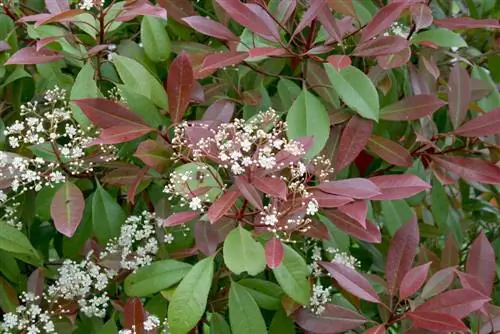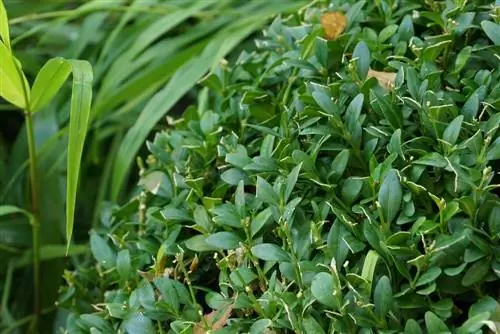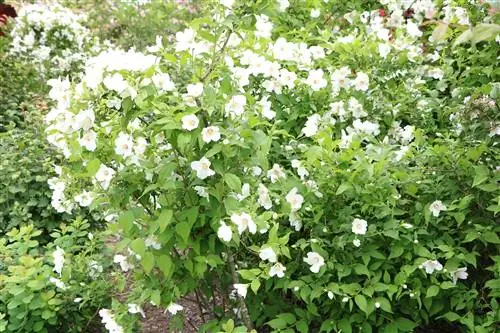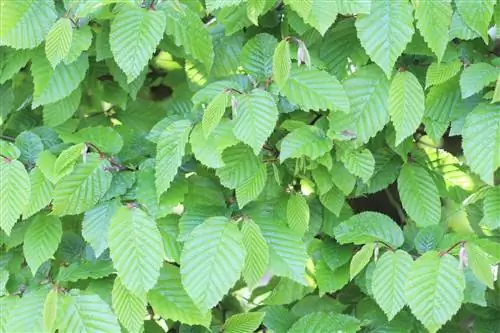- Author admin [email protected].
- Public 2023-12-17 03:39.
- Last modified 2025-06-01 06:48.
Hedges are not just suitable for privacy. They also store rainwater and filter exhaust gases, dust and pollutants. They also protect against wind and storms. Above all, evergreen hedges are able to slow down wind to a maximum of half its original intensity due to their dense foliage all year round. They can also compensate for temperature fluctuations in autumn and spring and thus have a positive influence on the microclimate in the garden. Below you will find a brief overview of popular, easy-care, evergreen hedge plants.
True Cypress
Real cypresses are evergreen, easy-care and undemanding conifers that grow between 40 and 60 cm per year. They can even thrive in urban and industrial climates and tolerate weather fluctuations between winter and summer very well. Its scale-shaped, dark blue-green foliage appears very lively and fresh even in winter. Cypresses are ideal as privacy plants in cut hedges up to 4 m high. They love a sunny to partially shaded location and humus-rich and well-drained garden soil.
Even if the real cypresses are very undemanding, they need to be watered regularly. They have a very difficult time surviving a lack of water. Hedge plants need a lot of water, especially in very windy locations, as the wind can dry out the soil quickly.
Tip:
Bark mulch as a protective layer on the garden soil helps prevent it from drying out!
Leyland cypress (Cupressocyparis leylandii)
- Growth height 20 to 30 m
- Growth width 10 to 15 m
- light green to dark green leaf color
- light brown to purple fruits
Tuja - Tree of Life
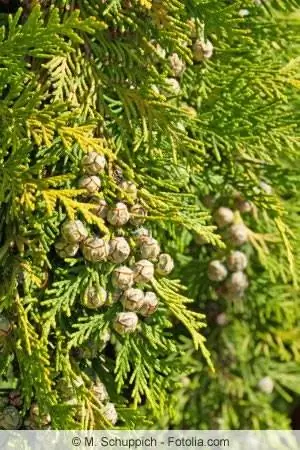
The thuja plant is one of the most popular evergreen hedge plants because of its low susceptibility to pests and diseases and its very good pruning tolerance. It grows approx. 40 to 60 cm per year. The soil can be slightly acidic for the thuja. Basically, a swampy soil is better suited for this hedge plant than one that dries out too quickly. Because it is very sensitive to dry periods. However, waterlogging should also be avoided so that the plants do not rot at the roots. The Thuja loves a sunny to partially shaded location. She doesn't tolerate shade at all and spends her time there.
Occidental Tree of Life (Thuja occidentalis)
- Growth height 5 to 15 m
- Growing width 0.5 to 1.5 m
- dark green leaf color
- Bird protection
- Bird food plant
Goldtip Tree of Life (Thuja plicata 'Aurescens')
- Growth height 10 to 15 m
- Growing width 5 to 7.5 m
- yellow-green leaf color
- Bird protection trees
Privet
The privet is one of the most robust, evergreen, easy-care hedge plants and grows 60 to 100 cm per year. The plant can survive in almost any garden soil, but prefers humus, loamy, sandy soil and loves a sunny to partially shaded location. If the privet is too shady, it will quickly show this with bare spots in its otherwise green foliage. It can be cut into shape very well all year round.
Privet 'Atrovirens' hedges (Ligustrum vulgare 'Atrovirens')
- Growth height 0.5 to 4 m
- Growth width 0.5 to 2.5 m
- narrow ovate to lanceolate leaves
- dark green leaf color
- white flowers
- slightly scented
- black, spherical fruits - poisonous!
- Bee Pasture
- Bird protection
- Bird food plant
Bamboo
The evergreen, easy-care bamboo is also ideal for planting hedges. Depending on the variety, it grows approx. 30 to 50 cm per year. Some bamboo species form widespread runners with their rhizomes and therefore require a rhizome barrier when planted for a hedge. Otherwise the beautiful evergreen privacy screen would grow into the neighboring garden or meadow.
Garden bamboo 'Crane' (Fargesia murieliae 'Crane')
- Growth height 3 to 4 m
- Growth width 1.5 to 2 m
- tight, upright growth
- requires little floor space
- no rhizome barrier necessary
- narrow, elliptical to lanceolate leaf shape
- good winter hardiness down to -25 C
Boxwood
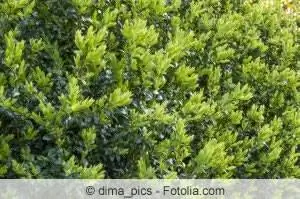
Boxwood hedges basically require little pruning and are absolutely hardy. Boxwood is very suitable for low hedges or bed borders in farm or herb gardens. It feels most comfortable in a sunny or partially shaded location. It does not tolerate shade, nor does it tolerate constant replanting. If you want to plant a hedge with it, it should not be moved again. It is important to have a permeable and loose garden soil that may contain some humus and lime. A hedge made of box plants only grows approx. 20 to 30 cm per year.
Heckenbuchs (Buxus sempervirens var.arborescens)
- Growth height 2 to 8 m
- Growth width 1 to 4 m
- small, ovate to narrowly elliptical leaves
- glossy, dark green leaves
- Bee Pasture
Yew
The yew only grows around 15 to 30 cm per year and is therefore even slower than the boxwood. However, it offers very good cutting tolerance by forgiving major cutting errors. As the most frost-hardy hedge plant in our latitudes, the plant is used in almost every garden or park. However, the seeds of their red berries are very poisonous! If the yew tree is cut annually, it does not produce any seeds. It likes moist, nutrient-rich and acidic soil and likes to be sunny. It also tolerates partial shade, but then grows even more slowly.
Native Yew (Taxus baccata)
- Growth height 10 to 20 m
- Growth width 5 to 10 m
- dark green leaf color
- needle-shaped leaves
- carmine red berries - poisonous!
- Bee Pasture
- Bird protection
- Bird food plant
Holly
Hollies love full sun locations, but can also survive in shady and partially shady locations. They prefer moderately moist soils that should always be well watered and never completely dry out. The holly does not tolerate waterlogging or dry periods. Birds like to use holly hedges as breeding grounds because the plants' spiny leaves keep them safe from cats. Holly trees require some winter protection after planting and during their juvenile stages. They grow 40 to 50 cm per year.
Common holly (Ilex aquifolium)
- Growth height 1.5 to 3 m
- Growth width 0.75 to 1.5 m
- glossy dark green leaf color
- bright red berries
- Bird protection
- Bird food plant
Cherry Laurel
All cherry laurel species are fast-growing and grow 40 to 50 cm per year. However, all parts of the plant are poisonous and difficult to compost. The laurel cherry is available in large and small varieties.
Cherry laurel - Caucasian laurel cherry (Prunus laurocerasus 'Caucasica')
- short and compact
- very frost hardy
- Growth height 0.5 to 3 m
- Growth width 0.5 to 2 m
- ovoid, elongated leaves
Tip:
A combination of cherry laurel, privet and holly, for example, is suitable for an evergreen, easy-care ornamental hedge that looks pretty all year round.
Conclusion
Most of the easy-care, evergreen hedge plants are extremely robust and winter-hardy, making them very suitable for privacy hedges around terraces or gardens. Cut resistance is also important here. When planting, you should always pay attention to the possible growth width of the individual plants. Because even if a hedge should grow beautifully opaque, the individual plants must not hinder each other's growth too much.


